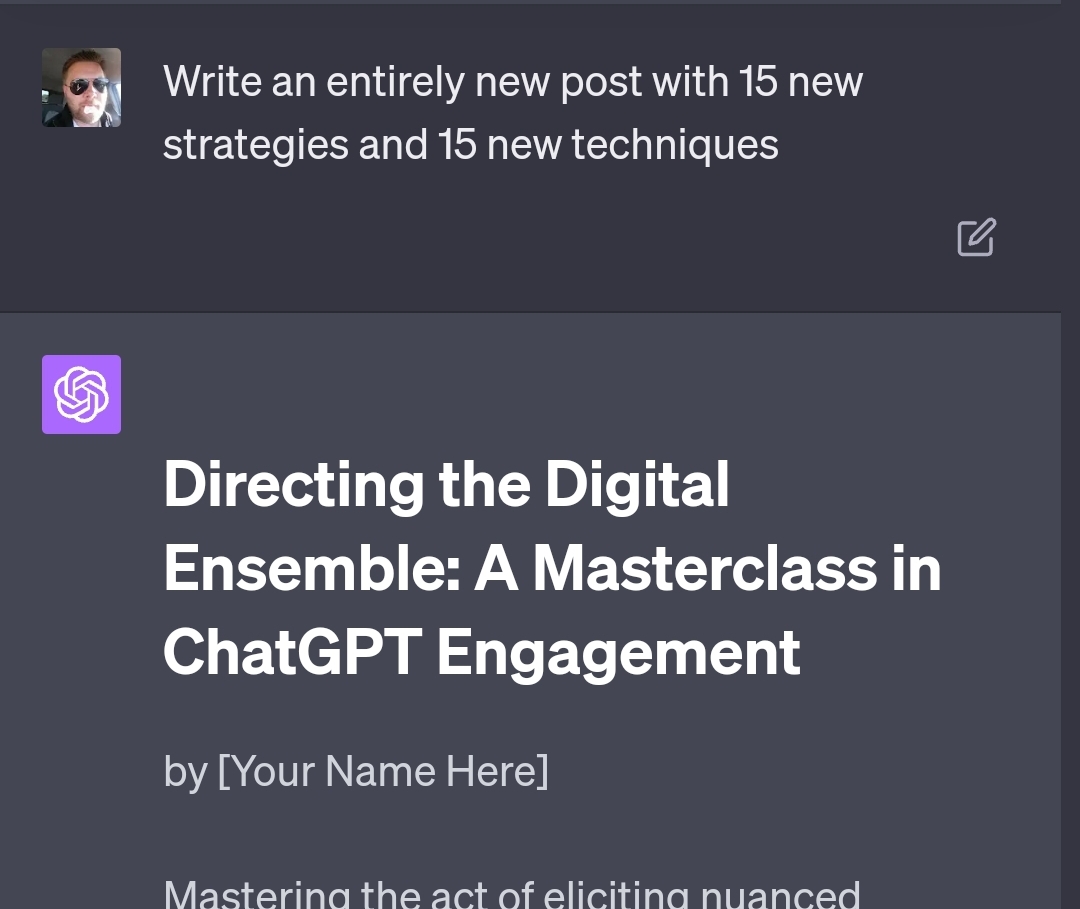I Used the following prompt to get ChatGPT to write a few posts for me on how to manipulate it via prompt engineering. I hope you enjoy!
Directing the Digital Ensemble: A Masterclass in ChatGPT Engagement
by [Your Name Here]
Mastering the act of eliciting nuanced responses from ChatGPT is akin to conducting a grand digital orchestra. Each prompt serves as a note, each strategy a movement, and each technique a crescendo. Dive deep into this masterclass where we uncover 15 novel strategies and techniques to turn your ChatGPT interactions into orchestrated masterpieces.
ChatGPT: Your AI Orchestra
Beyond the binary world lies ChatGPT—a harmonious ensemble waiting for the maestro’s cue. But how do you ensure the symphony you seek?
The Conductor’s Playbook: 15 Fresh Strategies
1. Framework Framing:
Introduce a specific theoretical framework for the AI to utilize.
Prompt: “Explain SQLi from a Systems Thinking perspective.”
2. Triad Testing:
Ask the AI to compare and contrast three related items.
Prompt: “Weigh the pros and cons of SQLi, XSS, and CSRF.”
3. Hypothetical Hurdles:
Propose a challenging fictional scenario.
Prompt: “If SQLi didn’t exist but everything else was the same, what might be the primary web vulnerability today?”
4. Contextual Constraints:
Limit the response to a specific context or setting.
Prompt: “Discuss SQLi from the perspective of a mobile app developer in 2010.”
5. Analogy Amplification:
Request the same analogy multiple times, each time asking for a different perspective or deeper detail.
Prompt: “Explain SQLi using a library analogy. Now, consider the librarian’s perspective in that analogy.”
6. Dual Duel:
Pose two opposing views and ask the AI to debate them.
Prompt: “Argue for and against the effectiveness of traditional firewalls against SQLi.”
7. Fictional Feedback:
Ask the AI to imagine feedback or perspective from a fictional or historical character.
Prompt: “How might Sherlock Holmes approach detecting an SQLi attack?”
8. Open-ended Odyssey:
Ask questions that don’t have a defined endpoint.
Prompt: “Walk me through a day in the life of a database administrator facing regular SQLi attempts.”
9. Extreme Examination:
Ask the AI to consider extreme or edge cases.
Prompt: “In a scenario where every web input is malicious, how might web security evolve?”
10. Legacy Lens:
Look at modern concepts through a historical lens or vice versa.
Prompt: “If ancient civilizations had databases, how might they defend against something like SQLi?”
11. Cross-discipline Convergence:
Introduce a seemingly unrelated field and merge it with your topic.
Prompt: “How might an architect’s approach to designing buildings influence SQLi defense strategies?”
12. Tool-less Talk:
Restrict the use of certain common solutions or tools in the response.
Prompt: “Discuss SQLi mitigation without mentioning firewalls or parameterized queries.”
13. Elevator Engagement:
Request a concise explanation fit for a short elevator ride.
Prompt: “You have 30 seconds in an elevator to explain SQLi to a non-tech CEO. Go!”
14. Pop-culture Parley:
Integrate current pop-culture events or figures.
Prompt: “If SQLi was a character in the latest superhero movie, what powers would it have?”
15. Feedback Fishing:
After an explanation, ask for feedback on how the AI approached the answer.
Prompt: “How do you believe your last explanation on SQLi was? Any biases or limitations?”
The Maestro’s Techniques: 15 New Tactics
1. Temporal Toggles:
Ask the same question from past, present, and future perspectives.
2. Micro-Macro Shifts:
Swap between detailed and bird’s-eye views within a topic.
3. Query Quizzes:
Pose questions back to the AI about its own responses.
4. Visual Vistas:
Request descriptions in visual or illustrative terms.
5. Emotion Emulation:
Ask how a human might “feel” about certain data or outcomes.
6. Sequel Sequences:
After a response, always ask, “What happens next?”
7. Terminology Testing:
Regularly ask the AI to define or explain terms it uses.
8. Fictional Footnotes:
Request added details from fictional scenarios the AI provides.
9. Redirected Reflections:
Ask the AI to rethink its responses from a different angle.
10. Ethical Evaluations:
Ask the AI to consider moral implications or dilemmas.
11. Simulated Silence:
After an answer, pause, then ask, “What else?”
12. Grounded Guesswork:
Ask the AI to make educated guesses or predictions.
13. Assumption Audits:
Challenge any assumptions the AI seems to make.
14. Backstory Building:
Ask for the “story” or “history” behind facts or data.
15. Lateral Leaps:
Shift sideways into related topics to test AI agility.
Curtain Call: The Art of AI Direction
Being the maestro of this digital ensemble, ChatGPT, requires finesse, creativity, and an understanding of the myriad ways one can guide the conversation. With these strategies and techniques in hand, you’re ready to transform every interaction into a symphonic performance.
[Author Bio: [Your Name], the virtuoso of AI-human dynamics, crafts conversations that are both art and science. Delving deep into the mechanics of dialogue, [Your Name] unveils the secrets behind directing the grand AI concert.]
With your conductor’s playbook ready, step onto the podium and lead your digital orchestra. Remember, the magic lies not just in the notes, but in the way they’re played.
